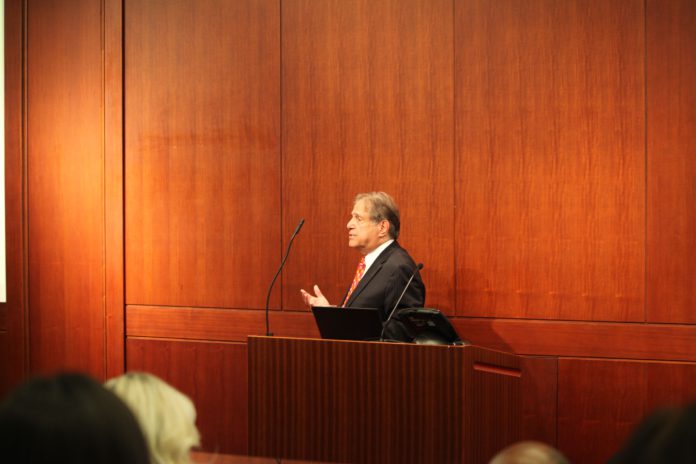
“If I were you I’d be wondering one thing: what’s this old white guy from Iowa doing talking to you about implicit bias?” Senior U.S. District Court Judge Mark Bennett asked the audience at the Center for Legal Inclusiveness-sponsored CLE on Thursday at the Ralph L. Carr Colorado Judicial Center.
But Bennett was the first judge in the nation to tackle the issue from the bench. He’s considered a national expert on the topic and developed jury instructions and methods in his courtroom to address the pervasive problem in the justice system. He discussed the psychology components that play into implicit biases and how we can combat them.
Bennett shared his personal experiences on bias and what led him to this work. Before teaching a legal ethics course on discrimination at Drake University, his colleague suggested he take an implicit-association test (a series of tests created by Project Implicit used in social psychology to measure implicit bias) on racial bias “because of his background.”
After his mother died, Bennett was raised primarily by an African American nanny with whom he was very close. He swore in one of the few black state court judges at the time in Iowa. Bennett said that after those experiences and 17 years in civil rights practice defending primarily black clients, he was surprised by his results: strong anti-black implicit bias. He took the test the next day, and again a week later. The outcome was the same.
“So, I did what any person trained as a lawyer would do: I assumed the test was invalid,” he joked. But the results sent him down the path toward understanding what implicit bias means in the context of the justice system.
Project Implicit started at Yale University and is now housed at Harvard University. Bennett has since taken tests on different biases (religion, race, gender, disability etc.) hundreds of times along with 15 million others who have taken them around the world. Researchers have found a few things: Implicit biases are pervasive, people are seldom aware of their implicit biases and implicit biases predict behavior. Bennett said he’s found the last point isn’t always true.
“Implicit biases sometimes predict behavior, but not always. It’s difficult to know because each person differs in their biases,” he said.
Bennett explained the types of bias and a psychological process called priming — where the brain groups information and sorts it accordingly, which in some instances triggers a stereotype. Priming can be subtle and happen subconsciously — most people don’t realize it’s happening.
One Harvard study of 1,000 incoming freshmen illustrated this through different email names. A third of students received an email from [email protected] (Asian prime), a third received one from [email protected] (gender prime), while the last third received the neutral prime, [email protected]. “Amy,” the email author, sent congratulatory emails to the freshmen and shared her own SAT scores. A week went by and students were asked to remember Amy’s scores. Students primed by the Asian name email remembered a significantly higher quantitative number and lower verbal number than the actual scores, and students primed by the gender email remembered a higher verbal number and lower quantitative number than the actual scores. The “no prime” email recipients remembered both numbers more accurately than the other two groups.
Bennett discussed subliminal priming and how it influences our brain to assess perceived threats based on those stereotypes and biases. MRI studies have shown that IAT results have a strong correlation with amygdala activation, which is basically the brain’s fear center. Implicit biases develop early on, and judges and jurors aren’t immune to their effects on perception. Bennett has found through his research that judges tend to have “bias blind spots” — where one is able to spot biases in others but is generally overconfident in one’s ability to control their own biases. He referenced a CLE program on state court administrative judges in New York.
They were asked to rate their own ability to avoid racial prejudice in judicial decision making compared to the others in the room — 97 percent rated themselves in the top half.
“Now I’m not very good at math, but that’s an impossibility,” he said.
Bennett shared the results of a 2014 study to illustrate how confirmation and implicit bias harms diverse attorneys as well.
Sixty partners were given two versions of the same memo with an associate’s name, seniority, alma mater and race. One associate was white, one was black. The partners were asked to rate the memo on different writing metrics. The black associate received 29 unsolicited comments and harsher criticism, while the white associate received 11.
Bennett concluded the session by sharing some changes he’s made to his docket and procedures to help check his own biases and the jurors he oversees. He had photos removed from his pre-sentencing reports and had a photographer come to the courthouse to shoot a naturalization ceremony for U.S. citizens. He had the portraits hung in the jury selection room.
He regularly practices “counter-stereotype imaging” and mindfulness — for example, when he sees dark-skinned defendants with Afrocentric features, he’s trained his mind to think of Dr. Martin Luther King, whose quote lives on Bennett’s office walls and email signature: “The arc of the moral universe is long, but it bends towards justice.” He encouraged audience members to take IATs and become aware of their own implicit biases.
“Each of you every day have the opportunity to bend that arc towards justice,” Bennett said.
—Kaley LaQuea

